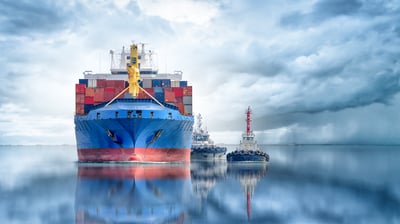5 surprise costs to watch for in ocean shipping
Ocean shipments involve a long chain of details that, if overlooked by importers, could come with hidden costs. Learn what some of these surprise costs are, and how you can avoid incurring them.
Don't turn smooth sailing into rough passage 
Shipping by ocean is a mode in which missed details or inaccurate information can quickly lead to additional costs. If you do not keep the entire shipment process in mind, from origin to delivery, you run the risk of incurring both unwelcome delays and unforeseen expenses while moving your shipment out of the ocean and onto any necessary land legs of the journey.
One of the most common mistakes we observe being made with ocean shipments is not using the correct Incoterm. This can lead to confusion at both origin and destination. It is equally important that buyers and sellers read the fine print to determine who is responsible for what requirements when making arrangements for your ocean shipments.
No surprises, please
Shipping in any modality can become costly - and quickly, too, especially if you are not paying attention. Depending on the agreed terms of the sale, the importer or exporter may be responsible for delivery and payment. However, there are some charges that importers are solely responsible for (in addition to Customs formalities) that could be unexpected.
Here are five of the most common surprise costs:
1) Customs exam fees (if required). Note that these are also not known in advance of shipping.
2) Destination terminal handling charges. These are not always included in ocean freight rates and can come as an added cost.
3) Detention of trailers or shipping containers. (Detention is the time it takes to empty the trailer or container and release it back to the carrier.)
4) Demurrage of shipping containers. (Demurrage is the time a full container spends on the dock or yard after being unloaded from the ship before being picked up).
5) Inland transportation. (That is, returning an empty container over a large distance, for example, if the port or cargo yard is far away from the receiving location).
The last potential expense on the list above is one that many importers may not be aware of and can particularly be an issue in Canada due to our sizeable geography. Usually, containers are booked to be returned to a steamship lines’ cargo yard (CY), but if there is a large distance between the yard and the receiving location, there may be additional fees associated with returning empty containers (and this can also lead to possible detention.)
For example, an import shipment may be terminating at the Vancouver, B.C. port of arrival, and the importer may be responsible for having that container picked up, emptied and returned to the carrier’s assigned yard. If the yard delivery address happens to be Edmonton, Alberta, and the container has to return to Vancouver, B.C., there could be a significant expense attached to returning that empty container.
Keep it moving
Although you are shipping by ocean, depending on where you are shipping to, there is often a land component. In Canada, our Canadian National (CN) and Canadian Pacific (CP) rail carriers are constantly moving their mark on wait times and availability. There is also the potential for delays in and around port cities that can be greater at times of heavy volume.
For the most part, dealing with CP and CN can be extremely difficult and time-consuming. Working with a freight forwarder from origin to door can remove that burden from you while also helping to mitigate any other issues that could arise.
Set sail for the unknown
If there is one thing that is clear to us in 2023, it is that uncertainty and unpredictability are the seas in which much of trade is swimming. When it comes to managing wait times, there is simply no clear-cut answer. In today's world where there are congestions at ports, lack of operators at ports and rail yards, as well as unforeseen upheaval occurring on all ends of the supply chain, it is not unlikely we'll see wait times ebb and flow. The best approach is to remain proactive with all of your shipments and partner with an experienced freight forwarder.
Freight forwarding. It's what we do.

Latest Articles
- Watch out for these extra charges on your freight bill
- Key differences between duty drawbacks and duty refunds for importers
- Mitigating container shortages and rising shipping prices for ocean imports
- How Canadian importers benefit from end use tariff codes and conditional relief
- The benefits of operating as a Non-Resident Importer in Canada
